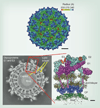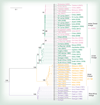Chikungunya virus and prospects for a vaccine
- PMID: 23151166
- PMCID: PMC3562718
- DOI: 10.1586/erv.12.84
Chikungunya virus and prospects for a vaccine
Abstract
In 2004, chikungunya virus (CHIKV) re-emerged from East Africa to cause devastating epidemics of debilitating and often chronic arthralgia that have affected millions of people in the Indian Ocean Basin and Asia. More limited epidemics initiated by travelers subsequently occurred in Italy and France, as well as human cases exported to most regions of the world, including the Americas where CHIKV could become endemic. Because CHIKV circulates during epidemics in an urban mosquito-human cycle, control of transmission relies on mosquito abatement, which is rarely effective. Furthermore, there is no antiviral treatment for CHIKV infection and no licensed vaccine to prevent disease. Here, we discuss the challenges to the development of a safe, effective and affordable chikungunya vaccine and recent progress toward this goal.
Conflict of interest statement
The authors have no other relevant affiliations or financial involvement with any organization or entity with a financial interest in or financial conflict with the subject matter or materials discussed in the manuscript apart from those disclosed.
No writing assistance was utilized in the production of this manuscript.
Figures





References
-
- Weaver SC, Frey TK, Huang HV, et al. Togaviridae. In: Fauquet CM, Mayo MA, Maniloff J, Desselberger U, Ball LA, editors. Virus Taxonomy, VIIIth Report of the ICTV. London, UK: Elsevier/Academic Press; 2005. pp. 999–1008.
-
- Brighton SW, Simson IW. A destructive arthropathy following chikungunya virus arthritis – a possible association. Clin. Rheumatol. 1984;3(2):253–258. - PubMed
Website
-
- Indian Immunologicals developing vaccine for chikungunya. [9 February 2012];The Hindu Business Line. www.thehindubusinessline.com/companies/article2875901.ece.
Publication types
MeSH terms
Substances
Grants and funding
LinkOut - more resources
Full Text Sources
Other Literature Sources
Medical
